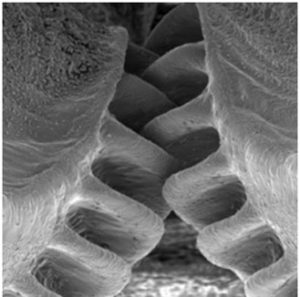Gears are cogwheels that usually operate in pairs. In other words, a cogwheel engages with another “toothed” wheel mechanism, in order to change direction or speed. Their purpose is the transmission of motion and as such we find them in every machine that aims at motion, such as bicycles, motorcycles and cars. They are considered as one of the oldest mechanisms known to humankind and one of the most important inventions. The question is, are they really a human invention?
Scientists Malcolm Burrows and Gregory Sutton, University of Cambridge, were the first to discover the existence of mechanical gears in nature. In their study, published in the scientific journal Science, they revealed the existence of curved cog-like strips of opposing “teeth”, on the hind legs of the insect Issus. Through a combination of anatomical analysis and high-speed video capture of Issus’ normal movements, the researchers were able to discover that these strips mix and rotate like mechanical gears, thus synchronizing the insect’s legs when it initiates a jump. This remarkable finding shows that mechanical gears, previously thought to be exclusively man-made, have an evolutionary “ancestor”. According to the scientists, this is the “first observation of mechanical gears in a biological structure”.

The gears on the rear ends of Issus have a remarkable technical resemblance to those found on bicycles or in car gearboxes. Each “tooth” on these wheels has a rounded angle at the point where it is attached to the cogwheel, a feature similar to artificial gears. This technically works as a shock absorber in order to prevent tooth decay. The gear teeth on the opposite legs lock together, ensuring almost complete synchronization in the movement of the legs. This lock is crucial for strong jumps which are the primary means of this insect’s transportation. Even tiny deviations in synchronization between the speeds of its legs, when propelled, would cause Issus to spin out of control. According to the researchers themselves, this precise synchronization would be impossible to control through the nervous system. This is because neural signals would take much longer to direct the extremely strict coordination that is required. The development of mechanical gears enables Issus to send nerve signals to its muscles in order to produce the amount of force required by one foot to initiate the jump. Then, the interconnection of the gears allows for the jump to be achieved through perfect synchronization.
“In Issus, the skeleton is used to solve a complex problem that the brain and nervous system can’t,” said Prof. Malcolm Burrows. “We usually think of gears as something that we see in human-designed machinery, but we’ve found out that is only because we didn’t look hard enough”, added Dr. Gregory Sutton. In addition, he highlights “These gears are not designed; they are evolved – representing high speed and precision machinery evolved for synchronisation in the animal world”.
How many secrets does nature keep…!? Could it be that it has the answers to all our questions?

RELATED ARTICLES
CONTACT US
____________
greekwomeninstem@gmail.com
Do you have ideas, questions, comments or special requests?
Would you like to highlight your research project or nominate a researcher that you would like to learn more about?
Please write to our email or fill out the form and hit “send”. We will be happy to talk with you!
[contact-form-7 id=”44″ title=”Contact form 1″]
